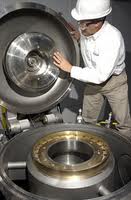Difference between revisions of "Micronizing Mills"
(Created page with "Category:Particle Size Reduction{{Knoppen}} <noinclude><!------------------------------------------------ * READ THIS FIRST * Only edit this page if you can improve the c...") |
PurplePen19 (talk | contribs) |
||
| Line 5: | Line 5: | ||
* Please do not edit the sponsored link on the top right corner. . | * Please do not edit the sponsored link on the top right corner. . | ||
* Please start editing this page after the /noinclude | * Please start editing this page after the /noinclude | ||
* -------------------------------------------------></noinclude> | * -------------------------------------------------></noinclude> | ||
[[File:Micronizing Mills_1.jpg|thumb|200px|right|Micronizing Mills]] | |||
'''Micronizing Mills''' are similar with the [[Micronizers]. The unique grinding action of the mill rapidly reduces troublesome 0.5mm particles to submicrometer sizes required for quantitative and qualitative analytical methods. Forty-eight cylindrical grinding elements produce both line contact blows and planar shearing, in contrast to the random contact blows of a conventional ball mill. | |||
Slurry grinding by either corundum or agate grinding elements, both included with the mill, is the preferred method in most laboratories. Liquids used for slurry grinding include water, deionized water, isopropyl alcohol, or cyclohexane. Isopropyl alcohol and cyclohexane are recommended for clays. | |||
The mill can accept up to approximately 4mL of material, although optimum grinding efficiency is usually achieved with a 2mL sample. | |||
The advantage of our mill is that the analyst can examine the sample after a 10-minute grind and if it is not fine enough, put it back on and grind for an additional 5-10 minutes depending on size to be achieved. Many samples are ready after 10 min. and few need more than 35 min. grinding time. | |||
The standard Mill package includes built-in process timer, 2 sets of agate grinding elements in jars with lids, loading device, extra mounting set, and pouring cap. | |||
==Features== | |||
Wet or dry grinding | |||
Even particle distribution | |||
Virtually no sample loss | |||
Reduces crystal lattice disturbances | |||
No chemical degradation of particles | |||
Dimensions: 480mm x 200mm x 165mm | |||
Weight: 36 lbs. in shipping crate | |||
Power (U.S.): 110-115V 60Hz | |||
Power (Europe): 220-240V 50Hz | |||
Grinder: Vibratory laboratory mill powered by a 1/30 HP motor | |||
==Video== | |||
<youtube>JG_CXtWJr-M</youtube> | |||
Latest revision as of 23:54, 14 October 2012
Micronizing Mills are similar with the [[Micronizers]. The unique grinding action of the mill rapidly reduces troublesome 0.5mm particles to submicrometer sizes required for quantitative and qualitative analytical methods. Forty-eight cylindrical grinding elements produce both line contact blows and planar shearing, in contrast to the random contact blows of a conventional ball mill.
Slurry grinding by either corundum or agate grinding elements, both included with the mill, is the preferred method in most laboratories. Liquids used for slurry grinding include water, deionized water, isopropyl alcohol, or cyclohexane. Isopropyl alcohol and cyclohexane are recommended for clays.
The mill can accept up to approximately 4mL of material, although optimum grinding efficiency is usually achieved with a 2mL sample.
The advantage of our mill is that the analyst can examine the sample after a 10-minute grind and if it is not fine enough, put it back on and grind for an additional 5-10 minutes depending on size to be achieved. Many samples are ready after 10 min. and few need more than 35 min. grinding time.
The standard Mill package includes built-in process timer, 2 sets of agate grinding elements in jars with lids, loading device, extra mounting set, and pouring cap.
Features
Wet or dry grinding Even particle distribution Virtually no sample loss Reduces crystal lattice disturbances No chemical degradation of particles Dimensions: 480mm x 200mm x 165mm Weight: 36 lbs. in shipping crate Power (U.S.): 110-115V 60Hz Power (Europe): 220-240V 50Hz Grinder: Vibratory laboratory mill powered by a 1/30 HP motor
Video
